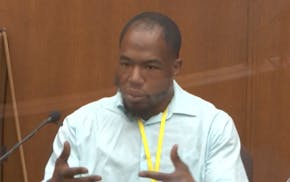Tiara Suarez was sitting in class when her teacher's phone rang.
Suarez, then a seventh-grader, was called down to the front office, where Child Protection Services was waiting for her and her siblings.
Suarez, her older sister and a younger brother were taken out of their unfit home in Minneapolis, she said, and moved into a shelter, where they stayed until leaving for a foster home.
Suarez, now 21, was born in California, raised in Salem, Ore., and later moved to Minneapolis with the only guardian in the picture, a relative. Her mother was in and out of prison, she said, and she didn't have a relationship with her father.
Suarez's story is all too common, said Wendylee Raun, the state adoption exchange and recruitment coordinator at MN Adopt, which offers resources and services to support adoptions. Raun helps facilitate adoptions between families and foster care youth.
"Foster parents take children into their home to give them a safe environment while their parents try and work out whatever the problem is that got the kids into foster care," Raun said. But some never reunite with their parents or guardians.
Thousands of youths are in foster care in Minnesota. In Hennepin County alone, 1,569 youths were in the foster care system as of June, and one-third of them were ages 13-20, according to county statistics. Nearly 120 kids in the county — the majority teenagers — were waiting for a family to adopt them as of May.
Suarez felt safe in her new Twin Cities home with an older couple as foster parents, she said. They enforced chores and clean rooms, and family outings were mandatory.
But the changes in her life were sometimes too much.
"I went from a happy, smiling person to depressed," she said.
Raun says children who end up aging out of foster care face a number of obstacles, including being at higher risk of having developmental, emotional and behavioral issues.
"I feel like not knowing my father, and not having a relationship with mom, it's had a big impact on my life," Suarez said.
Being in foster care also affected her "relationships, friendships, communication and self-worth," she said. "Moving from place to place, moving schools a few times, that's all had an impact on my communication and also my self-worth and confidence."
Still, with the support of her foster parents, the College Possible student graduated from Park Center High School and completed a semester at North Hennepin Community College.
Suarez is beating the educational odds for foster youth, but only by a little.
Only 50 percent of foster kids finish high school before age 18, according to a 2014 fact sheet from the National Working Group on Foster Care and Education. Just 20 percent of foster kids who graduate from high school attend college, according to the fact sheet. And less than 10 percent of former foster kids attain a bachelor's degree.
In other ways, Suarez falls in line with the statistics. Studies show foster youths who have aged out of care are at a higher risk to be unemployed and dependent on public assistance, and many find themselves homeless, imprisoned or become parents at a young age.
Suarez recently gave birth to her first child, a son. But, as of early August, she was unemployed, homeless and had only a few packs of diapers and a small collection of baby clothes, she said.
If she's learned anything through her experiences, it's to stay positive. She said she will share with her child advice her foster mother gave her:
"The most important person in the world is yourself," she said. "Of course everyone is equal. But to you, you should always love yourself first."

Minneapolis reaches $150k settlement with eyewitness of George Floyd's murder

Israel-Hamas war creates 'really fraught times' at Minn. colleges

Rare and fatal brain disease in two deer hunters heightens concerns about CWD

